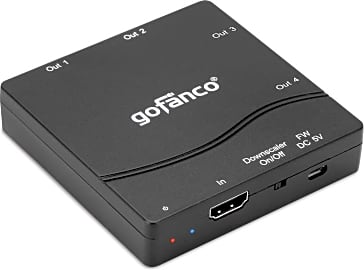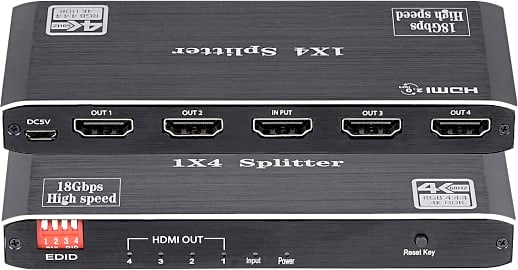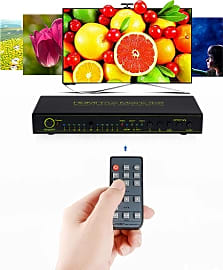The 8 Best HDMI Splitters

This wiki has been updated 43 times since it was first published in February of 2015. HDMI splitters are designed to turn one digital video signal into multiple streams, and they're often used as hubs for sales displays or sharing information between coworkers. Because they use essentially the same wiring as HDMI selectors or switches, some allow for bidirectional operation, letting you choose what you want to appear onscreen from several connected sources. When users buy our independently chosen editorial picks, we may earn commissions to help fund the Wiki.
Editor's Notes
December 03, 2020:
Splitters vs Switchers
It’s important to make a distinction between splitters and switchers here. A splitter must, by definition, be able to ‘split’ an incoming signal from a HDMI source. Thus, a splitter will have more than one output, for multiple displays. However, a model with more than one input regardless of number of outputs is typically referred to as a HDMI switch (or switcher), and we have a list of the best HDMI switches. By definition, will only include models with more than one output.
Typically, a switcher which has both multiple input and output ports is called a matrix switcher, and such a model gives you a lot of flexibility over switchers with only one output port. The matrix switchers in this list include the TESmart Switcher, as well as the NewPower Matrix.
Upgrades to This List
My main priority during the update was to remove all models that didn’t support HDMI 2.0a or higher, since a lot of older models that I’ve removed like the Cable Matters 103073 and Orei HDS-108 only supported up to HDMI 1.4. In total, I’ve removed 5 splitters and replaced them with models with similar builds like the Avedio Links Aluminum and Gofanco Prophecy that offered 2.0a or higher. One exception to this is the NewPower Matrix which only supports HDMI 1.4, but had other impressive features that warranted it a place in the list.
Is HDMI 2.0 Necessary?
There are a couple of differences between HDMI 1.4 and HDMI 2.0, the fundamental probably being that while both support 4K Ultra HD, 1.4 supports it at only up to 30 hertz (equivalent to frames-per-second), whereas 2.0 supports 4K at up to 60 hertz. This is essentially the refresh rate of your display, or how many times the video is ‘refreshed’ or changes in 1 second. So, a lower frame rate will have a ‘choppier’ look to it, and this is the reason why HDMI 2.0 is fundamental to unlocking the full potential of 4K Ultra HD. Fortunately, this is not a massive issue for many movies, as most are shot in 24 fps (frames-per-second), while only a handful to date have been shot at higher frame rates –the Hobbit, for instance, was shot at 48fps. However, many TV shows are shot at higher rates, and games, especially fast-paced ones, also look much 'smoother' at high refresh rates.
False Advertising Remember that your signal quality is only as good as your weakest link, so if you don’t have a TV that supports 4K UHD at 60fps or HDMI 2.0 cables, then a 2.0 splitter will do little good to help. On the other hand, many people in this market do appear to be actively looking for HDMI 2.0 splitters, but can often be duped into buying models that claim to support 4K at 60fps, only to read the manual and find out that they don’t. A good rule is to look for whether the model states the HDMI protocol it supports on the box itself, as many HDMI-2.0 compatible units, especially those that offer 2.0-b compatibility like the Newcare models and the Enbuer 4-Out, will proudly advertise this fact on their units, as they know that these units are ahead of the times. Other ‘clues’ to look for are whether the model also supports HDCP (High-bandwidth Digital Content Protection) 2.2 and data transfer rates of at least 18.0Gbps, as well as HDR (High Dynamic-Range Imaging), though, only 2.0a, 2.0b and 2.1 support this, and not 2.0.
Future Updates
The first 8K TV's recently came out, and as they start to become more popular, I'm sure that over the next few updates, this list will likely move towards HDMI 2.1, which will be able to support up to 10K.
August 30, 2019:
HDMI splitters can be used in the home to duplicate cable, satellite, or streaming video, in the workplace for information sharing, or in retail situations to increase the visibility of advertisements. If you tend to consume high-fidelity media, our top selections -- particularly the Orei and TESmart -- are worth a look because they're fully compliant with HDMI 2.0 standards. Not only that, they actually aren't terribly expensive for such effective devices. The Expert Connect is also interesting because it combines a splitter and switcher, letting you choose between connected feeds. For full control over inputs and outputs, check out the NewPower, which lets you mix and match the streams to the preferred screens, even including a convenient picture-in-picture mode. The Orei and NewPower also include built-in audio extractors which can be helpful if you're feeding sound through a high-end stereo receiver.
Then there are some simpler choices that can certainly do the job if you're not constantly streaming 4K shows and movies. Our top choice, the Orei, does come in a 1x2 model that should solve your problems if you only need to duplicate video once. The Keliiyo is a suitable low-cost choice although it doesn't have the advanced features of some more expensive options, and the Techole is worthwhile if you need a very inexpensive choice. Though it can't actually mirror a display, it does work in both directions. And if you're interested in capturing an HD or Ultra HD output, check out our list of HDMI recorders, which should all work quite well with any of these choices.
A Brief History Of The HDMI Platform
Companies such as Sony, Phillips, Panasonic, and RCA all worked in concert to develop the new interface format, with major research and development launched in April of 2002.
The word HDMI is an acronym for "High Definition Multimedia Interface." This is a rare example of a name that perfectly expresses what its namesake does: the HDMI interface, or the plug and cable that connects two devices, to put it simply, adroitly carries audio and video content, otherwise known as multiple types of media, that is of very high definition quality.
HDMI was developed through a joint partnership of many major technology firms, including groups from Europe, Japan, and the United States. Companies such as Sony, Phillips, Panasonic, and RCA all worked in concert to develop the new interface format, with major research and development launched in April of 2002. The goal of the joint team was more expansive and forward thinking than to simply create the next viable format for handling the ever increasing data loads of modern media; rather, they wanted to create a platform that would remain suitable for years into the future but that was also ** backward compatible** with older devices and media compression formats, such as DVI.
This approach was a remarkable and laudable departure from the common planned obsolescence seen in the technology world (think of companies that release a new and marginally improved phone every year, for example, in the hopes that consumers will continually upgrade their devices), and one that helped ensure that much of the hardware consumers already owned and that companies were already producing would remain viable into the future.
Serious testing of the new HDMI interface took place between 2003 and 2005, the year in which many consumer products, most notable television sets, first began to feature HDMI ports as part of their standard selection of inputs. Within a few short years, well over 1,500 companies had incorporated HDMI technology into their hardware.
The HDMI interface has proven its worth time and time again, remaining at the cutting edge of media transfer options well over a decade after its initial launch. And in fact, as of August of 2016, more than four billion HDMI-ready devices had been produced.
Why You Need An HDMI Splitter
When it comes to using one source on multiple display units, there really is no better option than an HDMI splitter. They offer users the ability to take one single input and display it on a virtually unlimited number of TVs or monitors. There are many situations where this technology can come in handy.
Not only would it be near impossible for them all to get a good view of the screen at the same time, but it would certainly hamper productivity as well.
In commercial settings, it often becomes necessary for multiple people to view a single video or image simultaneously. This could be because they are collaborating on a project, which is found to be beneficial, or because they all need to be exposed to the information simultaneously for efficiency reasons. Consider how difficult it would be for five or ten people to crowd around a single monitor. Not only would it be near impossible for them all to get a good view of the screen at the same time, but it would certainly hamper productivity as well. HDMI splitters provide this capability, without the need to purchase an overly large display screen.
Retail settings and events where multiple displays will be in use, whether for decoration or a shock and awe effect, can benefit from an HDMI splitter, especially one which offers buffering and amplification capabilities. A model with buffering will ensure that every display has a perfectly synchronized image. While the lag of a a few milliseconds may not sound like a big deal, it can appear very amateurish to viewers if they are able to see more than one screen at the same time, not to mention disorientating.
Educational settings can also benefit from the use of HDMI splitters. Using one in a classroom can allow each and every student to have a front row seat for whatever information they are being presented with, as long as they have access to some kind of monitor which takes input signals.
Finally, HDMI splitters often find a place in consumer's homes. As with commercial settings, this can be for use when collaborating with a friend on a project, or for more fun endeavors, such as a Superbowl party where you want to have one TV inside and another monitor outside for guests who are smoking so they don't have to miss a minute of the action. Instead of buying a completely separate TV, and perhaps a second cable box, you can just buy a standalone computer monitor and split your cable's signal, sending one to your TV as usual, and the other to your second monitor. These are just a few examples of how an HDMI splitter can be useful.
Choosing The Right HDMI Splitter
In life, so too with HDMI splitters, the simplest option is always the best. That is to say, if you are only looking to connect two or three displays to your source device via an HDMI cable, there is no need for you to select a splitter with eight output ports. A low cost, dual port HDMI splitter can be yours for well under twenty bucks, and will more than up to the job of handling your particular demands.
A low cost, dual port HDMI splitter can be yours for well under twenty bucks, and will more than up to the job of handling your particular demands.
These basic devices usually require zero setup beyond the physical connection of wires, and are a great choice for the person whose technological know how hits its peak just knowing they want to connect two HDMI wires but have only one HDMI output on their source.
On the other hand, even the top of the line, multiple port HDMI splitters are fairly affordable nowadays, which certainly makes these units viable choices for businesses or for academic and research institutions.
Before you settle on an HDMI splitter, make sure you are familiar with the hardware with which you will be using it, as many of today's advanced devices -- such as those outputting ultra high definition 4K or 3D content -- can overload the lower end units. If you enjoy media recorded in these advanced formats, then spend the money on an HDMI splitter which can properly buffer and amplify your media, avoiding delayed and/or improperly displayed content.
If you're unsure which devices you might be connecting via your HDMI splitter, it may be a wise idea to spend a little more and opt for a higher end unit; better to have a unit that is more capable than you need than to have one that's not up to snuff and must be replaced shortly.













